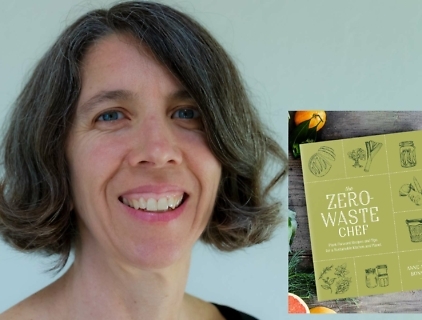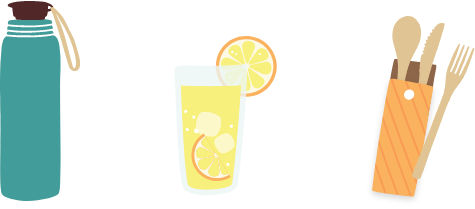Top 4 Plastics to Avoid – by the Zero-Waste Chef
The Plastic Free July Team | 10 July 2021
Start Here: Cut the Top Four Types of Plastic Waste
If you don’t know where to even begin when embarking on a month without plastic, start by cutting the “Top Four” single-use plastic items—widespread types of plastics that have quite simple and painless solutions.
- Plastic bags
- Water bottles
- Takeaway coffee cups
- Plastic straws
Why start?
If you’ve found yourself on the Plastic Free July website, you likely already know about the horrors of plastic pollution so I don’t need to expand on those here. The industries that produce the plastic have also promoted recycling as the ideal—and really the only—solution to the plastic pollution which they created. This push to recycle more shifts the responsibility—and cost—of cleanup onto consumers and municipalities that played no role in producing the waste. It also diverts attention away from the true source of the problem—production (that and psychotic greed). Corporations produce more plastic than our waste management systems can possibly absorb. (Read more about recycling here and here.)
While regulation of industry will lead to the kinds of sweeping reductions necessary to address the plastic pollution crisis, we need individual actions as well. Pressure from individuals at the bottom effects change at the top.
As you start: Do not feel guilty about a supply chain that you did not create
Our economic system revolves around the extraction, refining and burning of fossil fuels and their transformation into materials such as plastic. Because we will continue to decarbonize our society, Big Oil faces a challenge finding a market for a product with dwindling appeal. To continue profiting from fossil fuels, it has big plans to produce even bigger amounts of plastic.
More plastic production is hard to fathom. Already, for example, vast amounts of single-use plastic make their way onto grocery store shelves in the form of food packaging. The modern supermarket would look much different—and likely much smaller—without plastic to package the myriad shelf-stable, highly processed convenience foods. These foods enable the on-the-go lifestyles demanded by a system bent on productivity and growth at all costs, including the health of our planet, its life-support systems and all inhabitants.
In other words, our plastic-dependent, industrialized food system makes drastically reducing plastic difficult—but not impossible. Like the term “zero waste,” the term “plastic free” merely represents a goal. Although we may never reach the “zero” in zero waste or the “free” in plastic free, we can achieve the goal of Plastic Free July—to consume less single-use plastic.
Start with the Top Four Single-Use Plastics
You’ll find swapping these top four single-use plastic items for plastic-free alternatives quite painless.
- Plastic bags
In the US, people use 14,000,000,000 single-use plastic bags per year. Some stores get around plastic bag bans by offering very thick plastic bags, claiming that people will use them more than once. But handing out more plastic bags negates the intention of plastic bag bans—to encourage shoppers to bring their reusable bags to the store.
Buy or make some simple cloth produce bags
If we can adjust to taking our cloth shopping bags to the grocery store—and millions and millions have—we can adjust to using cloth produce bags as well.
You can buy cloth produce bags at health food co-ops, eco-friendly shops and online. You can also sew very simple produce bags if you prefer. Stash your produce bags in your shopping bags. Store the bags within bags near the front door, in your car or anywhere else that will help you remember to take them with you when you go shopping. Just as you wouldn’t leave home without your keys, you won’t leave home without your reusable bags.
- Water bottles
In the US, we consume 1,500 plastic water bottles every second for something that most of us can get free from our taps. Keep your money in your bank account and out of the coffers of corporations like Nestlé, which, during our current extreme drought in California, continues to steal millions of gallons of our water to sell in single-use plastic bottles.
Of course, you can’t drink unsafe water. But clever marketing, not actual need, motivates millions and millions of Americans to buy bottled water. And according to Food & Water Watch, 64 percent of bottled water is merely filtered municipal tap water. Not only that, bottled water may contain up to twice as many microplastics as tap water. (Microplastics are small pieces of plastic up to five millimeters in length.)
To avoid buying bottled water, carry a reusable water bottle or mason jar with you wherever you go. If you prefer to drink and cook with filtered water, install a water filtration system in your home.
- Takeaway coffee cups
Thin plastic lines the inside of paper to-go cups in order to prevent coffee and tea from leaking all over the place. Again, a mason jar works wonders. To prevent burning your hand, wrap a few rubber bands around the jar or sew a cloth sleeve for it out of scrap fabric or a worn-out sock. Or bring a ceramic mug with you to your café.
If, like many people, you have many mugs, keep one packed in your zero-waste kit, one in your car, one at the office (if your office doesn’t have real mugs, in which case, consider working on changing that) and so on. If you need to buy mugs, your thrift shop may have a large shelf full of them.
The café I frequented for seven years has never offered ceramic, for-here cups and suspended its bring-your-own-cup program during Covid. I haven’t been for over a year. When I called recently to ask if I could now bring in my own cup, I learned that the BYOC program will not likely return. Disappointed, I stumbled upon a different café that serves hot drinks in ceramic cups and brews possibly the best pu-erh tea I’ve ever tasted (this café adds cacao nibs). So I now treat myself to that occasionally and mostly drink tea I brew myself at home (which saves a small fortune).
- It’s not just a straw
Anti anti-plastic people like to claim that eliminating straws won’t make a difference. However, even the lowest estimate of just over 170,000,000 plastic straws used per day in the US is excessive. And besides, people who start their plastic reduction by refusing plastic straws won’t likely stop there. No doubt they will become more aware of plastic pollution and more active in addressing the problem. Straws, like each of these Top Four plastic items, are a gateway to reducing more plastic.
Of course, no one advocates the taking away of straws from anyone with disabilities who needs them. But for those of us who can drink without a straw, we can either lift the glass to our lips or buy reusable metal or glass straws. I don’t need or want these myself but I know that many people love theirs.
Starting down the plastic-free path is hard. You can’t change your routine overnight and sometimes, just when you get your routine down, new obstacles will pop up (hello, Covid). But the point is to use less plastic. Do that and you’ll succeed this Plastic Free July.
Short bio
Anne-Marie Bonneau writes the blog Zero-Waste Chef. She has lived plastic-free since 2011 and shows others how reducing their trash not only benefits the planet but also satisfies their taste buds, improves their well-being, and boosts their bank accounts. Her cookbook, The Zero-Waste Chef: Plant-Forward Recipes for a Sustainable Kitchen and Planet, is now out. Learn more from Anne-Marie in Plastic Free July Cook A Long.



